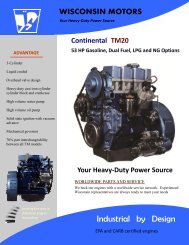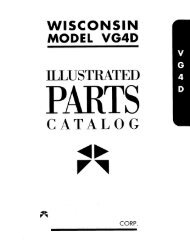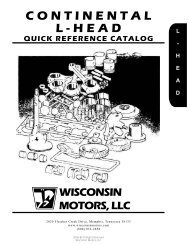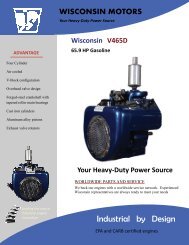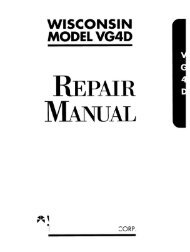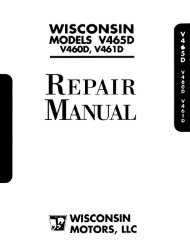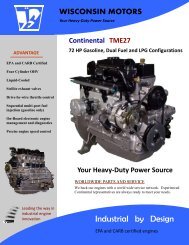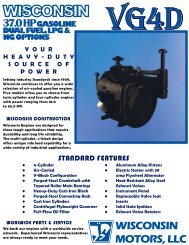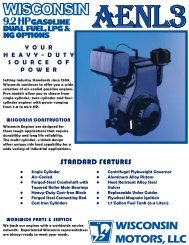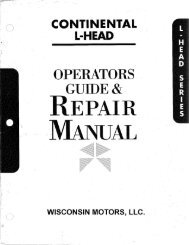REPAIR MANUAL - Wisconsin Motors
REPAIR MANUAL - Wisconsin Motors
REPAIR MANUAL - Wisconsin Motors
- No tags were found...
You also want an ePaper? Increase the reach of your titles
YUMPU automatically turns print PDFs into web optimized ePapers that Google loves.
Desirable Crosshatch Pattern Obtained with a Cylinder Hone<br />
After all honing operations are complete,<br />
thoroughly wash the bores with soap, hot water<br />
and a stiff brush to remove all traces of grit.<br />
Kerosene or other solvents will not remove the<br />
grit. Rinse the block with clean, clear water and<br />
dry with compressed air.<br />
Oiling Bores<br />
If not, the bores must be rewashed. As<br />
soon as the bores have dried, lubricate with<br />
engine oil immediately to prevent rust. This<br />
completes the honing operation.<br />
PISTONS<br />
Check the pistons for excessive ring groove<br />
wear, and replace any that exceed the allowable<br />
limits in our Limits and Clearance Data.<br />
The cylinder walls and pistons must be perfectly<br />
clean and dry when fitting pistons in the<br />
cylinder bores. Pistons should be fitted with the<br />
block °- and piston at room temperature 20.0<br />
21.0 °C (68 °-70 °F).<br />
Cleaning Bores<br />
PISTON FIT ON STANDARD PISTONS<br />
(with 2.3 to 4.5 kg (5 to 10#) Pull)<br />
TMD series 0.08mm (.003")<br />
When you have finished cleaning the<br />
block, run a clean, dry paper towel through<br />
the bores. The paper towel should come out<br />
clean.<br />
Check the piston fit in the bore using a half-inch<br />
wide strip of feeler stock, of the thickness<br />
specified in the Limits and Clearance Chart, the<br />
feeler being attached to a small scale of approximately<br />
7 kg (15 Lbs.) capacity.<br />
Checking Block for Cleanliness<br />
Checking Piston Fit in Bore<br />
47



